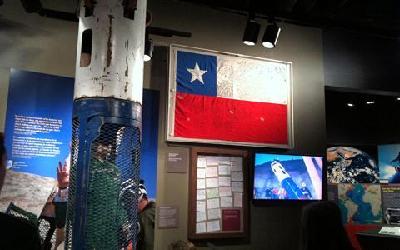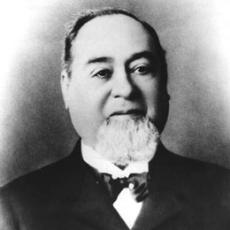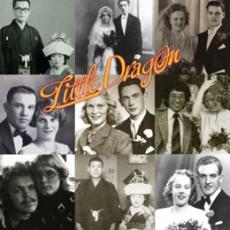
(MUSIC)
DOUG JOHNSON: Welcome to AMERICAN MOSAIC in VOA Special English.
(MUSIC)
I'm Doug Johnson. This week on our show, we have music from a new album by the Swedish electronic group Little Dragon ...
And we answer a question about the history of blue jeans ...
But, first, we take you to a new exhibit in Washington about last year's rescue of 33 miners in Chile.
(MUSIC)
Chilean Miners Exhibit
DOUG JOHNSON: One of the Smithsonian museums in Washington has a new exhibit about the rescue of 33 trapped miners in Chile. It opened on August 5th, the one-year anniversary of the mine collapse. Pat Bodner has more.
PAT BODNER: The exhibit is called "Against All Odds: Rescue at the Chilean Mine." It tells about the geology of the Andes Mountains, where the San Jose mine is located. The area is rich in minerals including copper and small amounts of gold.
The Smithsonian exhibit is in the gems and minerals area of the National Museum of Natural History. It explains the rescue operation with images and a timeline. All descriptions are in English and Spanish. The exhibit includes objects like a Bible and a watch that belonged to the miners.
Last August 5th, at 1:40 in the afternoon, there was a huge collapse. The miners were taking a break near the bottom of the mine. All of them survived the collapse. But huge piles of fallen rock meant they were trapped.
The Chilean government launched a rescue effort. There were three separate drilling operations. These used different technologies in case one operation failed.
Workers drilled a small opening to send food, water and other supplies to the miners.
The exhibit notes that people from around the world came together to organize the rescue. Workers and drilling equipment came from the United States, Canada and other nations. The American space agency gave Chilean officials information to help the miners survive long-term isolation. NASA also helped design the rescue container that brought the men to safety.

An example of this steel "Phoenix" rescue capsule is part of the exhibit. The capsule is very narrow, about 53 centimeters in diameter. Nutrition experts kept the miners on a careful diet to make sure they would be able to fit inside.
On October 13th, rescue workers used the container to lift the 33 men, one by one, out of the mine. They had been trapped for 69 days. A large screen in the exhibit shows video of the men arriving at the surface.
(SOUND)
However, recent reports say life has not been easy for the miners in the past year. Some are still being treated for the emotional trauma of being trapped more than half a kilometer underground. Many are unemployed. Movie and book deals have yet to lead to the wealth the men had been promised.
The rescue increased the popularity of President Sebastian Pinera. But now his policies have made him the target of violent anti-government protests. And some people have turned against the rescued miners for seeking millions of dollars in legal damages. The men -- once celebrated as heroes -- have brought action against the Chilean government and the owners of the mine.
(MUSIC)
Blue Jeans
DOUG JOHNSON: Our listener question this week comes from Kazakhstan. Lunara Katayeva wants to know the history of blue jeans.
Actually another listener in Russia asked the same question a couple of years ago. But we will answer it again because blue jeans represent American culture.
Levi Strauss did not invent jeans, but he is considered the first person to make and sell great numbers of them.
He was born in Bavaria, an area that today is part of Germany. In 1847 he and his family immigrated to the United States.

Levi Strauss opened a small dry goods store, first in New York, then in San Francisco, California. Among the products he sold were jeans. These pants were especially useful for miners in California. They needed clothing made from a strong material. Jeans are usually made from a heavy cotton cloth called denim.
Levi Strauss partnered with a clothing maker named Jacob Davis. Davis had invented a process for making rivets for jeans. These little metal connectors helped hold the pieces of cloth together to make the jeans stronger.
In 1873, the government gave Strauss and Davis a patent for their invention. That meant no one else could legally copy it without their permission. They began producing what they called "copper-riveted waist overalls."

In 1928 the Levi Strauss company registered the word "Levi's" as a trademark for their product.
The Smithsonian's National Museum of American History in Washington has one of the oldest known pairs of Levi's.
Writer James Sullivan published a book called "Jeans: A Cultural History of an American Icon." In it, he says jeans represent two American values, creativity and rebellion.
Cowboys wore jeans in the old Wild West. In the 1950s, people saw famous Hollywood actors like James Dean and Marlon Brando wearing jeans in movies.
Today jeans come in blue but also lots of other colors and in many styles and in all prices. Some designers charge 300 dollars or more for a pair of jeans.
Some people like to buy jeans that look fresh and new. Others like to buy new jeans that are torn and look old. What kind of jeans do you like? Tell us at voaspecialenglish.com.
(MUSIC)
Little Dragon "Ritual Union"
HOST: Little Dragon will be performing next week in California and New York. Christopher Cruise tells us about this four-member band from Sweden and the new album they just released.
(MUSIC)
CHRISTOPHER CRUISE: That song is called "Shuffle a Dream" from Little Dragon's new album, "Ritual Union." Yukimi Nagano sings about a rich, self-important man. The song says he can choose any girl but "why would you want someone so vain?"
You can hear the influence of rhythm and blues and jazz in the dreamy music of Little Dragon. But this song called "Summertearz" has a world-beat sound.

(MUSIC)
Little Dragon first came together in 1996, but did not release their first album until 2007. "Ritual Union" is the band's third album. We leave you with the title track.
(MUSIC)
DOUG JOHNSON: I'm Doug Johnson. Our program was written by Dana Demange and Caty Weaver, who was also our producer. If you have a question about American life, send it to mosaic@voanews.com or click on the Contact Us link at voaspecialenglish.com. You can also follow us on Facebook and Twitter at VOA Learning English.
Join us again next week for music and more on American Mosaic in VOA Special English.
gem: a crystalline rock that can be cut and polished for jewelry 宝石
emotional trama: 情感创伤
denim: a coarse durable twill-weave cotton fabric 斜纹粗棉布
Chopsticks for China, made in America
New music from Beyonce and an exhibit on "Perfect Girls"
New young artists honored with awards from Scholastic Corporation
Remembering folk artist Bill Morrissey
(来源:VOA 编辑:实习生史莉萍)
